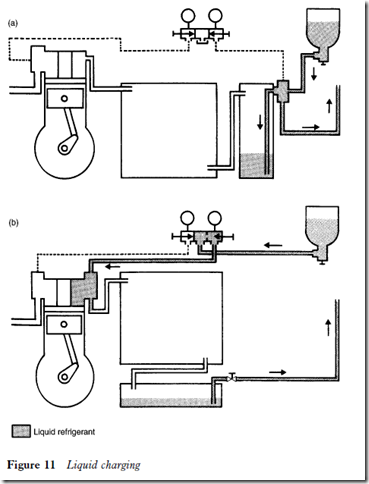Liquid charging
This method is not always acceptable to manufacturers, since it involves putting refrigerant liquid into the high side of the system. If the compressor discharge valves are not seating properly there is a danger of liquid refrigerant entering the compressor cylinders, which can cause damage due to dynamic pressure when the compressor starts. The liquid cannot be compressed without creating high pressure.
Some large condensing units are equipped with liquid charging valves on the receiver. Smaller hermetic and semi-hermetic units have service valves located on the receivers, and these can be employed for charging.
Liquid charging is carried out when a system is commissioned, or when it has been completely discharged of refrigerant.
Compressors should be at rest when the system is being liquid charged.
A simple method is by gravity, and should be performed carefully for the initial liquid charge (Figure 11a):
1 Fit gauges and connect to a refrigerant cylinder as shown.
2 Fully open the charging valve or service valve.
3 Open the valve on the refrigerant service cylinder and invert the cylinder.
As long as the pressure in the service cylinder is greater than that in the system, the liquid will flow. The flow will be audible.
4 When the flow has ceased, allow gauge pressures to stabilize, close the valve on the service cylinder and operate the plant.
5 Complete the charging in vapour form to the low side of the system.
To eliminate the possibility of compressor damage, the following procedure may be adopted (Figure 11b):
1 Run the compressor for a few revolutions with the discharge service valve fully front seated until a pressure of 20 to 30 psi (1.5 to 2.0 bar) is registered in the pressure gauge. This will be compressor cylinder pressure.
2 Stop the compressor.
3 Invert the refrigerant cylinder and open the valve or open the liquid charging valve as appropriate.
Table 1 Initial charges (kg) for various compressors and refrigerants and for flooded and dry evaporators
|
Compressor capacity kW |
R12 Flooded |
Dry |
R22 Flooded |
Dry |
R502 Flooded |
Dry |
|
0.5 |
1.4 |
0.7 |
1.4 |
0.7 |
1.4 |
0.7 |
|
0.75 |
2.7 |
1.4 |
2.7 |
1.4 |
2.7 |
1.4 |
|
1.0 |
4.0 |
2.0 |
4.0 |
2.0 |
4.0 |
2.0 |
|
1.5 |
5.5 |
2.7 |
5.5 |
2.7 |
5.5 |
2.7 |
4 Open the liquid charging valve or service valve on the receiver.
5 Crack off the discharge service valve. High pressure from the compressor on the surface of the liquid refrigerant in the cylinder will force the liquid into the condenser and receiver.
6 Set the discharge service valve to the operating position, close the liquid charging/service valve and the refrigerant cylinder valve, and operate the plant.
7 Complete the charge in vapour form.
With water cooled condensers the pressure will normally be greater in the refrigerant cylinder than in the system.
As a guide to refrigerant charges, Table 1 gives approximations for the initial charges to be administered to systems employing both flooded and dry expansion evaporators.
Liquid charging is to be carried out more frequently since the new and replacement refrigerants become available. The current and more efficient method is when the refrigerant is added via the liquid receiver as shown in Figure 11b.
